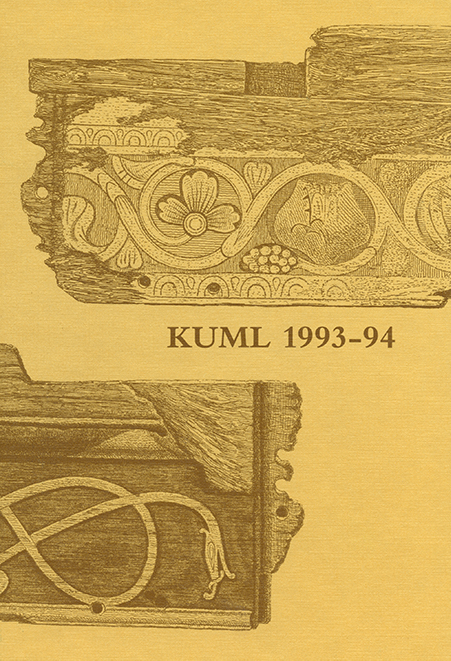Drinking Glasses from an Iron Age settlement from Dejbjerg, West Jutland
DOI:
https://doi.org/10.7146/kuml.v39i39.111966Keywords:
drinking glass, dejbjerg, west jutland, iron age, house, settlementAbstract
Drinking Glasses from an Iron Age settlement from Dejbjerg, West Jutland
Close to the findspot of the two late PreRoman Dejbjerg wagons, 3 contemporary settlement areas have recently been mapped (fig. 1). The new find dated to the late 5th or early 6th century A.D. was located within one of these, and was excavated in the summer 1993. In a burned-down, very solidly based building, measuring 16.5x4.5-6 m were found almost 100 sherds of drinking glasses in the postholes and in the topsoil above the house (70 pieces) (fig. 2-6). All fill was examined with a finemeshed sieve.
The glass sherds are fresh, with new and old fractures, or burned and melted with sandy surface. The colours of the sherds are yellow green, light green, warm yellow to cool green and blue green. On all sherds with trailing and blobs these have the same colour as the glasses, except a bowl with a white thread inlayed in the rim.
The following glasses can be identified: one light green glass horn, one light green beaker with blobs and a zigzag-trailing below the rim, one yellow-green footed beaker with a spiral trailing around the neck and looped trailing on the body, one yellow cone(?) beaker, with the same type of trailing, three cone beakers in cool blue green, yellow green and light yellow green, three yellow bowls and one supposed blue green flask (fig. 7-10). In all at least 6 different types of glasses and eventually some more undecorated and not yet identified types have been identified. In total 10 to 12 different glasses were present in the house.
Traces of wear, found on at least 8 of the glasses, are of great importance for the interpretation of the house. This leads to the conclusion that they have been used, problably in the building where they were found. Also objects of bronze and iron have been found, including fragments of a bronze neckring. The only other finds were two pottery vessels and some bones of domestic cattle (fig. 11-12). Some finds in the topsoil may originate from the burned down building (fig. 13).
The distributions of the sherds of glass within the house shows clearly that all the glasses were kept in the eastern part, with some differences in the distribution of each glass (fig. 14).
Recently the Swedish archaeologist Frans Herschend proposed a theory about Iron Age halls in the 5th and 6th centuries A.D., including social and political aspects of function as forerunners of the well known halls of the Viking Age. As examples building-area 1A at the Helgö-site in Sweden and house Vb in Dankirke near Ribe are emphasized. New excavations at Gudme on Funen have produced further examples. The Dejbjerg building might be interpreted in this light. An example of a possible, not-burned Iron Age hall, is known in the Mørup farmstead (fig. 15).
The discussions concerning trade and centers of richness in the late Iron Age in Denmark have up to now not been applicable in the mid-Jutland area, but a new site in Sdr. Haurvig, at the expected Iron Age sea-connection through Ringkøbing Fjord, probably played a role at the time (fig. 16). Here, a great number of coins from the edge of the dunes have been found. A Roman coin and a sceatta show the use of the site in the Iron Age. The rest of the coins are of later date, and this makes it difficult to understand the significance of the coins and the possible connection to Dejbjerg, as no other Iron Age objects have been found.
An evaluation of the significance of Dejbjerg in the late Iron Age points to the existence of a west Jutland site, not yet located, with supra-regional political and religious importance. Dejbjerg is assumed to have functioned as a part of this system. In the PreRoman Iron Age the Dejbjerg ceremonial wagons connected the area with Dankirke near Ribe and Langå near Gudme. Later in prehistory and early historical times no center is known. The town Ringkøbing can only be traced back on to about 1200.
Torben Egeberg Hansen
Downloads
Published
How to Cite
Issue
Section
License
Fra og med årgang 2022 er artikler udgivet i Kuml med en licens fra Creative Commons (CC BY-NC-SA 4.0).
Alle tidligere årgange af tidsskriftet er ikke udgivet med en licens fra Creative Commons.


